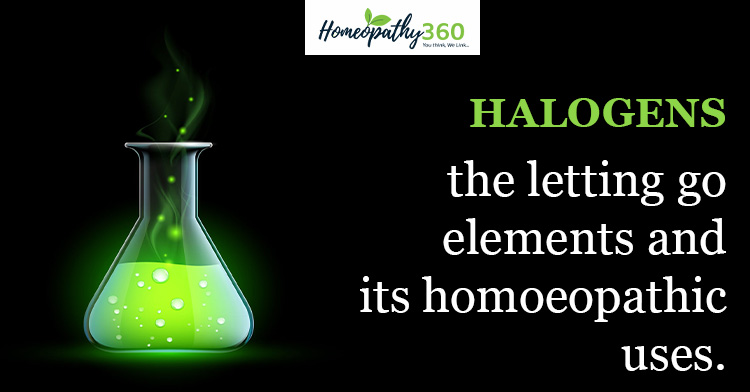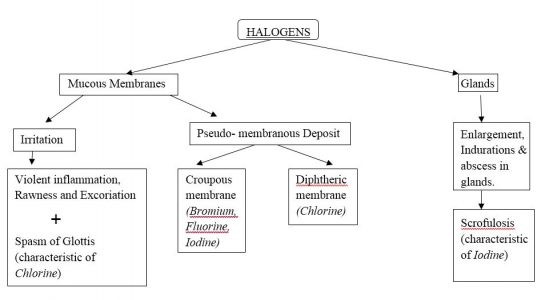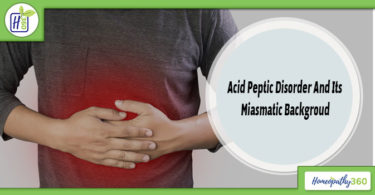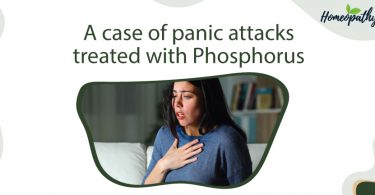
Halogens – the letting go elements and its homoeopathic uses
Abstract – The halogens belongs to group 17 in the periodic table consisting of five elements: fluorine (F), chlorine (Cl), bromine (Br), iodine (I), and astatine (At). As they have seven valance electron hence require one electron to complete their outer orbit and become stable, so they constantly trying to get one electron and hence these halogen remedies are very active, restless, excited and anxious. They are unstable alone so they usually form compounds to become stable and in nature they are mostly found in combined state like Calcarea iodatum, Calcarea flouricum, etc. that are used as homoeopathic remedies. Hence, their individual actions are difficult to interpret from compound forms but are more known to us in different compound forms.
Keywords – halogens, homoeopathy, periodic table.
Abbreviations – fluorine (F), chlorine (Cl), bromine (Br), iodine (I), and astatine (At).
Introduction
In the periodic table group 17 elements are known as the halogens consisting of five chemically related elements: fluorine (F), chlorine (Cl), bromine (Br), iodine (I), and astatine (At). In Greek words ‘halos’ means ‘sea salts’, and ‘genes’ means ‘production’. It is so originated due to their close resemblance and gradual transition of physical and chemical properties. As they have seven valance electrons, missing just one electron each to fill their shells, hence require one electron to complete their outer orbit and become stable, so they constantly trying to get one electron and hence these halogen remedies are very active, restless, excited and anxious. Due to their high reactivity, the halogens are found in the environment only in compounds or as ions. The halogens are the only group which contains elements in all three familiar states of matter at standard pressure and temperature, where fluorine and chlorine are gases, bromine is a liquid and iodum and astatine are solids.[1][2]
Mental Sphere
On the mental plane, the main feeling in halogens is that they don’t need anyone much that they are nearly complete in themselves. So, they don’t want to be tied down or bound for too long.
The word describing the halogens – letting go, holding on, exciled, climax, demanding uncontrolled, final end.
According to Dr Jan Scholten, –halogen series is the eradication, all has to be erased. It has to be ceased, extinguished, abolished, aborted, and finalised. One can be forced to quit or flee, being expelled as an outcast. To let go everything, even forget memories. It frees, makes one loose from bonds. One can let go with humour. The opposite is to hold on to things, even taking them without asking.[2]
- Restless, excitable people–There is a decided erethism, during which the patient is very excitable, and restless, moving about from place to place, now sitting here, now sitting there, he fears that every little occurrence will end seriously. want to be doing something continuously. They are active, agile people.
- Impulsive – They wanted to do things quickly, impulse to do violent and strange things, tendency to become destructive, tendency to ruin things which they don’t like.
- Violent and destructive – they take harsh and violent measures.
- Forgetful – Forgetfulness is a characteristic symptom. There is a lot of things crowding in their mind that they can’t keep up with it. They are inclined to write everything down on little notes, but even then they keep forgetting certain things.
- Obsession – Their fear of forgetting things might become an obsession. This may lead to compulsive behaviour, all because they want to be able to keep everything under control. This results in fixed ideas: ‘I have to do this, and I must do that’.[1][2]
Physiological action[3]
The chief action of halogens are mainly on mucous membranes and glands.

Few important halogen remedies
- Fluorine
- Chloralum
- Bromine
- Iodine
Fluorine[1][4][5]
The chemical preparation of the element is very difficult since it combines with nearly every substance with which it comes in contact but especially with water, forming hydrofluoric acid.
Fluorine in its pure elemental form. It is the most reactive of all the non-metallic elements and it affects every substance it comes in contact with, even metals like Platina.
- For actions on the organism only compounds of fluorine come under consideration, Acidum fluoricum, Calcium fluoricum.
- The bones and teeth are richest in fluorine. The fluorine content in man is found increased with older ages.
- Acidum fluoricum was proven by Dr Hering and his circle of provers in Philadelphia.
- From clinical use it has been shown that Acidum fluoricum has a slowed but deep, prolonged action. The supportive tissue is the favored site.
- It acts on the bones, especially the long bones, causing caries and necrosis, and favours the expulsion of the necrosed part.
- Fistulae, rectal, dental, and lachrymal come within its sphere.
- Vascular erethism:
- Heated state without real fever.
- Fluoric acid has amelioration from cold applications, bathing in cold water.
- Itching, worse from warmth. Aggravation from warmth in any form, also from warm drinks. Profuse sweats.
- Muscle unrest.
- Sexual excitation (as in beginning diseases of central nervous system).
Mental – as they belong to row2, there is complete separation. They are completely independent and separate.
They forms and breaks relationships readily. Attachment to a person becomes burdensome for them and so they get completely separated. [5]
Chloralum
Chlorine is of great significance in the organism in the ionic form, primarily in its neutral salt compound with sodium.
The homoeopathic use of chlorine in the form of potentised chlorine water, aqua chlorata, is recommended in croup, spasm of the glottis, asthma with expiratory dyspnoea, coryza with sudden flow of acrid, corrosive mucus, and loss of voice in damp weather.
- Laryngeal spasm is especially pronounced; the chief difficulty is in exhaling, can draw in the air well enough.
- Coryza with sudden gushes of sharp, corroding fluid, making nose sore inside and about the alae.
- Sudden dyspnoea from spasm of the vocal cords, with staring protruding eyes, blue face, cold sweat, pulse small.
- Convulsive attacks on cutting eye-teeth.
- Mouth inflamed and ulcerated.
- Many complaints, especially the constipation, are said to be aggravated at the seashore.
- Mostly females, emaciation in spite of a good appetite, pale gray cachectic appearance, dry skin and mucous membranes, chilly but intolerant to the sun’s heat, physically and mentally exhausted.
- Tendency to migraine, basedowism.
periodicity, aggravation during and after the irregular menses. [1][4][5]
Mental – as they belong to row 3, they have issues with finding identity and nourishment. They feel betrayed, hurt, and let down by the identity given to them so they want to be free from them and assumes a completely opposite identity.
Very forgetful; he cannot remember names.
Bromine
Bromine was isolated from the mother liquor of the Mediterranean Sea in 1826 by Ballard. It is often found in the animal organism in slight amounts, particularly in the thyroid. Indeed, the bromine content of the blood is essentially higher than the iodine content.
- It is also useful in hypomanic state (sedative and antiepileptic action).
- The chief use of bromine preparations in homoeopathy has been in affections of the upper air passages.
- The glands (thyroid, testes, maxillary, parotid) are swollen and indurated.
- There is much anxiety of mind; a fear of ghosts or visions when in the dark.
- Like the other halogens, Bromine is a strong anti-scorbutic.
- Amelioration at the sea-side; but aggravation in sailors when coming ashore they suffer from asthma.
- Migraine, chiefly left side, < from stooping, especially after drinking milk.
- Hypertrophy of heart from gymnastics in growing.
- Physometra – loud emission of flatus from the vagina.
- Cold sensation in larynx on inspiration better after shaving. [1][4][5]
Mental – as they belong to row 4 they are more concerned about security and task. They have a feeling of insecurity and of being completely alone to face danger and attack.
- No one to protect.
- Fear of ghost, being pursued, conscience, hitting punished.[5]
Iodium
Iodine is an element necessary for the mammalian organism but it is not essential for the general electrolytic economy, for the regulation of osmosis and colloid states, but has specific functions as a catalyser.
Baumann found iodine in the thyroid in 1895 and in 1927 Harington and Barger made a chemical determination of thyroxin (tetra- iodophenol ether of tyrosin), to which may be ascribed the chief action of thyroid. Besides this, di-iodo-tyrosin, it appears, has a weaker action.
- The homoeopathic indications, according to the symptom register of Hahnemann, are swelling of the neck with numerous sensations of tension, oppression and compression of the throat.
- Iodium is especially suited to persons of dark hair and complexion; dark, yellow, tawny skin.
- The iodine picture is an example of the oxygenoid constitution of Grauvogl, in which the oxygen influence is increased.
- Ravenous hunger; eats freely and well, yet loses flesh all the time.
- Hypertrophy and induration of glandular tissue thyroid, mammae, ovaries, testes, uterus, prostate or other glands. Breasts may dwindle and become flabby.
- Aggravation from heat, in a warm room, and moreover at rest.
- Amelioration from walking around and in the open air.
- On the sexual organs the toxic atrophy is preceded by an irritative phase.
Earlier iodine was used as an emmenagogue. Too early and too profuse menses are the most frequent form of menstrual disturbance with iodine. [1][4][5]
Mental – as they belong to row 5 they have issues of facing the new, performance, creativity. There is a feeling of completely alone and unguided in a new and dangerous situation.
- Cannot depend on anybody.[5]
Conclusion
Thus halogens have proved to be efficacious in scrofulous acting on glands, respiratory affections, cancerous and various other kinds of affections. Iodum and Bromium are quite well proved but Flourine, Chlorine and Astatine are not well proved and need extensive proving and clinical trials to explore their inherent powers to cure different diseases.
References
1. Lesser O, Textbook of materia medica by Otto lesser B Jain Publishers (P) Ltd; reprint edition 2001.
2.Scholten J. Homoeopathy and minerals, Homoeopathic Educational Services 1st edition ,august 2007 .
3. Farrington E.A. Lectures on Clinical Materia Medica in Family Order. New Delh: B. Jain Publishers (P) Ltd; 2012.
4.Clarke J.H. A Dictionary of Practical Materia medica. vol 3,B. Jain Publishers (P) Ltd; 2009.
5.Sankaran R. STRUCTURE Experiences with the mineral kingdom ,vol 1,edition 2008 Homoeopathic medical Publishers, Mumbai.
About Author:
Dr Neha Sahu MD (PGR)
Dept. of Materia Medica,
Dr. M.P.K.Homoeopathic Medical College, Hospital and Research Centre, Jaipur (A constituent unit of Homoeopathy University, Jaipur, Raj.)





